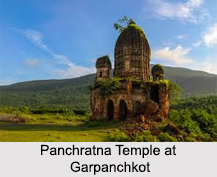 Located at the foothills of the Panchet Hills in the north-east corner of the Purulia District in the state of West Bengal, Garpanchkot is a newly found tourist destination. Standing at an elevation of about 2000 m, the Panchet Hill is dotted with tropical tress and below the hills flow the Damodar River. The natural splendour of the woods accompanied with the lush greenery makes Garpanchkot an ideal tourist destination.
Located at the foothills of the Panchet Hills in the north-east corner of the Purulia District in the state of West Bengal, Garpanchkot is a newly found tourist destination. Standing at an elevation of about 2000 m, the Panchet Hill is dotted with tropical tress and below the hills flow the Damodar River. The natural splendour of the woods accompanied with the lush greenery makes Garpanchkot an ideal tourist destination.
Etymology of Garpanchkot
The name Garpanchkot evolved from the words "gar" or "garh" which basically means fort. Here, it is referred to the fort of the king of Kashipur who constructed a garh (fort) and a temple on the Panchet Hill.
History of Garpanchkot
Garpanchkot is a part of the nearly 1500-year-old history of the Singh Deo dynasty. The only remains of this kingdom are the temple ruins on the southern Panchet foothills with scattered ruins of various terracotta forms of temples around Garpanchkot. With a rich culture and a religious past, the Garpanchkot region still has the kings of the surviving Panchakot family, who had once ruled this region uninterrupted from 940 A.D. till 1750 A.D. But due to the Mughal attacks, Garpanchkot had to shift their fort to Kashipur.
Climate of Garpanchkot
The region of Garpanchkot has a tropical type of climate with a distinct summer and winter seasons. The summer months between April to June are to be avoided by tourists because of the scorching heat while the monsoon season brings some relief when the flora and fauna of the region comes to life. But the tourist influx happens the most during the winter season when the temperature ranges between 8 degree to 14 degree Celsius and the weather is pleasant to roam around and trek.
Tourism of Garpanchkot
Rich in history, Garpanchkot with the ruins of temples and forts has become an attractive tourist spot along with its hills and forests. One of the famous attractions of Garpanchkot is the Garpanchkot Fort, which has several ruined spots and has the ruins of the Panchratna Mandir and Jorbangla Mandir of Garh. The terracotta designs of the Panchratna Mandir are the prime attractions of this place. Apart from the fort, the ruins of Kalyaneswari Temple, Panchet Dam, nearby the Santhal villages, and the Panchet hills with its lush green forests etc are also popular among the tourists. Among these, the Panchet dam is ideal for nature lovers and from here one can get an astounding view of Panchet hills.
Visiting Information on Garpanchkot
Garpanchkot can be visited by both road and rail. Nearest railway station to this place is Barakar railway station. Regular trains are available from Howrah station to reach Barakar. From Barakar, a car or an auto can be hired to reach the destination. The place can also be reached by road via Asansol and then Deshergarh. This place is 65 km from Purulia, 25 km from Adra and 34 km from Barakar.



















